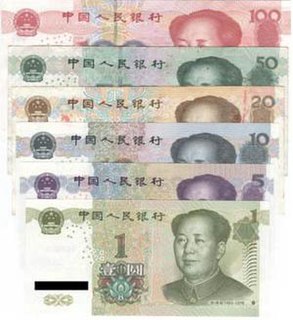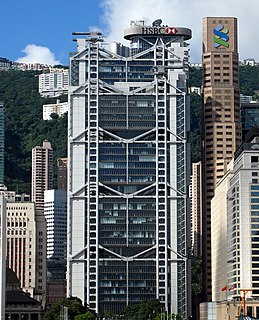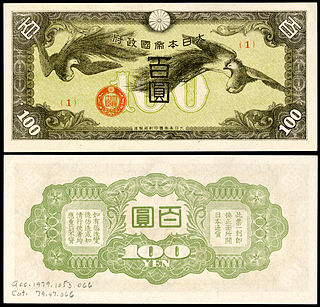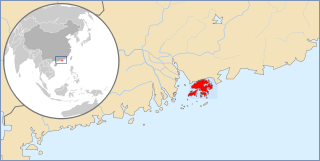| (Hong Kong) | |
|---|---|
| Value | 150 Hong Kong dollars |
| Width | 153 mm |
| Height | 76 mm |
| Material used | Paper |
| Years of printing | 2009, 2015 |
The Hong Kong one hundred and fifty dollar note is a commemorative banknote issued by the Standard Chartered Bank (Hong Kong) on 1 October 2009 and HSBC on 2015 to commemorate on the 150th Anniversary of the Standard Chartered Hong Kong branch [1] and HSBC respectively. It is the world's first 150 base unit denomination banknote. [2] Approximately 1 million notes were issued by Standard Charter and 2 million by HSBC. Owing to its rarity and expected higher re-sale value, the notes are unlikely to enter circulation, though they are still considered legal tender.

The renminbi is the official currency of the People's Republic of China and one of the world's most traded currencies, ranking as the eighth most traded currency in the world as of April 2019.
The Hong Kong dollar is the official currency of the Hong Kong Special Administrative Region. It is subdivided into 100 cents or 1000 mils. The Hong Kong Monetary Authority is the monetary authority of Hong Kong and the Hong Kong dollar.

The Macanese pataca or Macau pataca is the currency of the Macau Special Administrative Region of the People's Republic of China. It is subdivided into 100 avos, with 10 avos called ho (毫) in Cantonese.

Standard Chartered plc is a multinational bank with operations in consumer, corporate and institutional banking, and treasury services. Despite its UK base, it does not conduct retail banking in the UK, and around 90% of its profits come from Asia, Africa, and the Middle East.

Bank of China Limited also known as its short name Bank of China or BOCHK, is a subsidiary of the Bank of China. Bank of China is the second-largest commercial banking group in Hong Kong in terms of assets and customer deposits, with more than 190 branches across Hong Kong as of the end of 2019. It is also one of the three commercial banks licensed by the Hong Kong Monetary Authority to issue banknotes for the Hong Kong dollar.

The Hongkong and Shanghai Banking Corporation Limited, commonly known as HSBC, was the parent entity of the multinational HSBC banking group until 1991, and is now its Hong Kong-based Asia-Pacific subsidiary. The largest bank in Hong Kong, HSBC operates branches and offices throughout the Indo-Pacific region and in other countries around the world. It is also one of the three commercial banks licensed by the Hong Kong Monetary Authority to issue banknotes for the Hong Kong dollar. | logo = HSBC logo (2018).svg The Hongkong and Shanghai Bank was established in British Hong Kong in 1865 and was incorporated as The Hongkong and Shanghai Banking Corporation in 1866, and has been based in Hong Kong ever since. It was renamed "The Hongkong and Shanghai Banking Corporation Limited" in 1989. It is the founding member of the HSBC group of banks and companies, and, since 1990, is the namesake and one of the leading subsidiaries of the London-based HSBC Holdings PLC. The company's business ranges from the traditional High Street roles of retail banking, commercial banking, corporate banking to investment banking, private banking and global banking.
The Chartered Bank of India, Australia and China was a bank incorporated in London in 1853 by Scotsman James Wilson, under a Royal Charter from Queen Victoria.

Japanese military currency was money issued to the soldiers of the Imperial Japanese Armed Forces as a salary. The military yen reached its peak during the Pacific War period, when the Japanese government excessively issued it to all of its occupied territories. In Hong Kong, the military yen was forced upon the local population as the sole official currency of the territory. Since the military yen was not backed by gold, and did not have a specific place of issuance, the military yen could not be exchanged for the Japanese yen. Forcing local populations to use the military yen officially was one of the ways the Japanese government could dominate the local economies.

The issue of banknotes of the Hong Kong dollar is governed in the Special Administrative Region of Hong Kong by the Hong Kong Monetary Authority (HKMA), the governmental currency board of Hong Kong. Under licence from the HKMA, three commercial banks issue their own banknotes for general circulation in the region. Notes are also issued by the HKMA itself.
The Mercantile Bank of India, London and China, later Mercantile Bank Ltd, was an Anglo-Indian bank with business focus in the Far East. It was founded in Bombay in 1853 as the Mercantile Bank of Bombay; and later in 1857 was renamed to Mercantile Bank of India, London, and China with London as its headquarters.

Standard Chartered Hong Kong is a licensed bank incorporated in Hong Kong and a subsidiary of Standard Chartered. It is also one of the three commercial banks licensed by the Hong Kong Monetary Authority to issue banknotes for the Hong Kong dollar.

The Standard Chartered Bank Building is a skyscraper located in Central, Hong Kong. The tower rises 42 storeys and 191 metres (627 ft) in height. The building was completed in 1990. It was designed by architectural firm P & T Architects & Engineers Ltd.
The Hong Kong one hundred dollar note was first issued from 1858 from the Mercantile Bank, 1866 by the Oriental Bank Corporation, the Standard Chartered Bank from the 1860s but a confirmed date for this bank is 1879, followed by The Hongkong and Shanghai Banking Corporation in 1877. Specimens are known from the Agra and Masterman's Bank and the Asiatic Banking Corporation that existed between 1862–66 and from The National Bank of China in the 1890s. There was a continuous issue till the Second World War in different colours and dimensions, and this issue was resumed after the war in 1946, by the HSBC, Mercantile and Standard Chartered Banks. This was somewhat standardised in 1970 when the Chartered Bank changed the issue from brown to red, red was the colour of the other two issues. The Mercantile bank stopped issuing banknotes after 1974 and the Bank of China issued their version in 1994. The colour was made uniform when red for all banknotes was adopted.
The Hong Kong five hundred dollar note was first issued in undated from the 1860s by the Oriental Bank Corporation, the Standard Chartered Bank but a confirmed date for this bank is 1879, followed by The Hongkong and Shanghai Banking Corporation in 1877, the Mercantile Bank in 1948 and the Bank of China in 1994. The Specimens are known from the Agra and Masterman's Bank and the Asiatic Banking Corporation between 1862-66. The National Bank of China issued theirs in the 1890s. There was a continuous issue till the Second World War in different colours and dimensions, they were reissued from 1946. The Mercantile bank ceased issue of this denomination after 1959. There was a standardisation of size in 1979 when the Chartered Bank reduced the size to that similar to HSBC. The colour was made uniform in 2003 when brown for all banknotes was adopted.
The one thousand-dollar note is the highest-valued banknote in circulation in Hong Kong. Currently, this note is issued by the Hongkong and Shanghai Banking Corporation (HSBC), Standard Chartered Hong Kong, and the Bank of China. Due to its gold-colored theme, this note was nicknamed “Gold Cow ” by the locals, derived from the term “Big Cow ” that is used for the city's five hundred-dollar note. If counted according to the notes’ serial number, it is the note with the second-lowest printing figure, higher than that of the fifty-dollar note.
The five-dollar note was first issued in 1858 by the Mercantile Bank, 1865 by the Standard Chartered Bank, 1866 by the Oriental Bank Corporation, 1897 by The Hongkong and Shanghai Banking Corporation, and 1894 by the National Bank of China. There was a continuous issue until the Second World War in different colours and dimensions, and this issue was resumed after the war in 1946, by the HSBC and Standard Chartered banks. The various banks' designs were somewhat standardised in 1970 when the Chartered Bank changed the issue from green to brown, as this was the colour of the HSBC issue. The Standard Charted Bank issued two colours from 1967 to 1970, a yellow and green note. These are described as being a yellow and green key in reference to the image of two keys on either side of the banknote. This denomination was replaced by a coin in 1976.

The paper money of the Qing dynasty was periodically used alongside a bimetallic coinage system of copper-alloy cash coins and silver sycees; paper money was used during different periods of Chinese history under the Qing dynasty, having acquired experiences from the prior Song, Jin, Yuan, and Ming dynasties which adopted paper money but where uncontrolled printing led to hyperinflation. During the youngest days of the Qing dynasty paper money was used but this was quickly abolished as the government sought not to repeat history for a fourth time; however, under the reign of the Xianfeng Emperor, due to several large wars and rebellions, the Qing government was forced to issue paper money again.

The Zhuangpiao, alternatively known as Yinqianpiao, Huipiao, Pingtie (憑帖), Duitie (兌帖), Shangtie (上帖), Hupingtie (壺瓶帖), or Qitie (期帖) in different contexts, refer to privately produced paper money made in China during the Qing dynasty and early Republic of China periods issued by small private banks known as qianzhuang. Other than banknotes qianzhuang also issued Tiexian.

The banknotes of the Ta-Ching Government Bank, known as the banknotes of the Ta-Ching Bank of the Ministry of Revenue from 1905 to 1908, were intended to become the main form of paper money in the Qing currency system. These banknotes were issued by the Ta-Ching Government Bank, a national bank established to serve as the central bank of the Qing dynasty. The Ta-Ching Government Bank had branches throughout China and many of its branches outside of its headquarters in Beijing also issued banknotes.